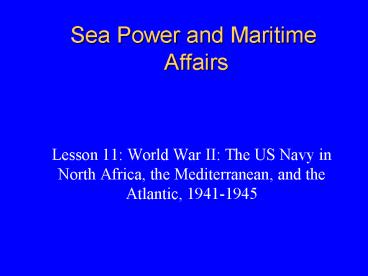Sea Power and Maritime Affairs - PowerPoint PPT Presentation
1 / 26
Title:
Sea Power and Maritime Affairs
Description:
The students should appreciate the complexities of strategy-making in a war ... The question of Navy-Army rivalry must be considered in explaining and ... – PowerPoint PPT presentation
Number of Views:186
Avg rating:3.0/5.0
Title: Sea Power and Maritime Affairs
1
Sea Power and Maritime Affairs
- Lesson 11 World War II The US Navy in North
Africa, the Mediterranean, and the Atlantic,
1941-1945
2
Learning Objectives
- Comprehend the internal political situation in
the U.S. during the period before December 7,
1941 relative to American involvement in overseas
problems. - Know that Germany was the greatest threat to
European and North American security. - Know U.S. attempts to remain neutral prior to
1941. - Comprehend the absolute priority given to keeping
the sea lanes to Britain open. - Know the relationship between Roosevelt and
Churchill in the establishment of the United
Nations and the broad concepts of Allied strategy.
3
Learning Objectives (cont)
- Comprehend the confrontation between German
U-boat strategy versus Allied convoy
Antisubmarine (ASW) strategy in the Atlantic. - Know German surface raider effectiveness .
- Comprehend the differences between British War
of Attrition versus American plans for a direct
confrontation with Germany. - Comprehend how Allied amphibious landings
assisted in ending the war in Europe.
4
Germanys Invasion of Europe
- Sept 1939, Germany invades Poland. England and
France declare war on Germany - 1939-1940 brings inconclusive results on the
western front - Britain moves to blockade Germany
- Germany begins commerce raiding with U-boats and
surface raiders
5
1 Sep 1939 Germany Invades Poland
6
(No Transcript)
7
Germanys Invasion of Europe
- Germany invades Norway, April 1940
- - Action designed to keep Britain from
tightening blockade by mining northern approaches - May 1940 Germans launch attack on low countries
and France - Outflank the Maginot line
- France falls June 1940
- Britain withdraws troops from Europe
8
British Convoy Strategy
- Strategy adopted from the outset
- Recognizes the importance of keeping the lines of
communications open with the U.S. - Dönitz organizes U-boats to hunt in Wolfpacks
to prey on convoys. Was very effective when
based out of France and Normandy. - U-Boat sinkings climax in fall of 1940.
9
17 Sep 1939 U-29 sinks carrier HMS
CourageousU-47 sinks Royal Oak.
10
HMS Courageous
11
HMS Courageous sinking
12
Hitler giving awards for sinking of HMS Courageous
13
HMS Royal Oak
14
HMS Royal Oak
15
HMS Royal Oak
16
Enlisting American Help
- British acquire more escorts and the ability to
break the German Ultra Code - The U.S. drifts into undeclared war with Germany
attempts to maintain neutrality, 1939-1941 - FDR an internationalist/ interventionist
- Congress influenced by isolationist and America
First propaganda. - FDR runs for third term under isolationist
platform. Later passes the first peacetime
draft. - FDR knows a German victory would threaten US
security because it would destroy British sea
power which was thought to be the Shield of the
Republic.
17
Enlisting American Help
- US sends Neutrality Patrols to help British
ASW. - All aid to Britain short of war includes
destroyer-bases deal and Lend-Lease program. - FDR concedes this is not Wilsons neutrality in
thought and deed.
18
U.S. Enters War
- U.S. officially enters war after attack on Pearl
Harbor - Germany U-boat offensive moves to the U.S. East
Coast - As the Convoy Strategy becomes more effective,
Doenitz moved his U-boats south (tonnage
strategy) - Doenitz shifts U-boats back to North Atlantic in
1942. U.S. counteracts with escort carriers and
HF/DF locations of Wolfpack - Doenitz forced into Central Atlantic as allies
strengthened convoys and developed ASW tactics.
Hunter-Killer groups run out of U-boats to sink
19
Germanys Surface Fleet
- Germany used surface raiders with moderate
success. No large surface battles in Atlantic,
as German surface fleets had a hard time breaking
out into the Atlantic.
20
Competing Allied Strategies.
- British preferred a peripheral strategy
- War of Attrition
- North Africa
- Egypt
- Sicily
- U.S. preferred direct attack on Germany through
western France - Operation Roundup
21
US went with Brits
- Allowed U.S. to pursue Pacific War
- Drew German resources off the Western Front,
weakening them for an eventual cross channel
invasion - Allies checked German advances in Egypt
stalemated on Russian front attacked Italy
beginning in July 1943
22
Competing Allied Strategies
- Sequence for pursuing peripheral strategy in the
Mediterranean - Operation Torch
- Operation Husky
23
Operation Torch
- General Dwight D. Eisenhower
- Western Naval Task Force
- Rear Admiral H. Kent Hewitt
- Major General George S. Patton
- D-Day 8 November 1942
- Target is Casablanca
24
Operation Husky
- Invasion of Sicily
- Same General Officers as Torch
- More sophisticated amphibious landing
- LSTs, LCTs, LCIs
- Night landing
- Mussolini falls from power
25
Competing Allied Strategies
- Allies spend next year building up in England for
cross channel invasion - Normandy Overlord
- invasion (June 1944)
- Southern France Dragoon
- (August 1944)
- succeed in pushing Germans back into its
borders. - Spring 1945 War ends in Europe.
26
Discussion
Next time World War II The US Navy in the
Pacific, 1941-1945































